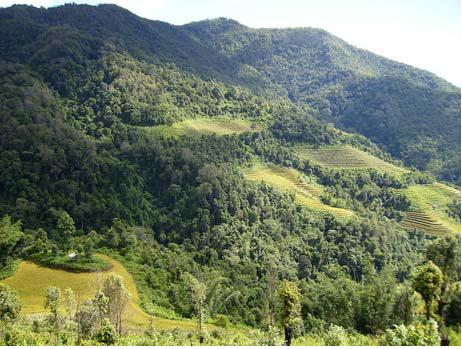
Figure. Much of the gibbons' natural habitat has been converted to
farmland (cited from the paper).
The Nangunhe Nature Reserve in Southwest Yunnan (PRC) has long been presumed to be the last stronghold of lar (or white-handed) gibbons (Hylobates lar) in China and the likely to be the last place of occurrence of Hylobates lar yunnanensis.
Kunming Institute of Zoology (KIZ) researchers, Jiang Xuelong and Guan Zhenhua, in collaboration with scientists from Dali and Switzerland conducted a comprehensive survey to assess the status of lar gibbons at Nangunhe.
From the survey, they found no visual or auditory evidence of them still residing at the reserve and therefore tentatively concluded that lar gibbons have become extinct in China.
They suggested that large-scale destruction of primary forests in the 1960s and 1970s brought about an initial decline in their numbers, and subsequent uncontrolled hunting has resulted in their extirpation.
The situation for the six Chinese ape taxa is nothing less than disastrous, with 1 taxon assumed to have become extinct during the last few years, 1 taxon not having been confirmed since the 1980s, and 2 species at the very brink of extinction with only tens of individuals remaining in China.
Grueter CC, Jiang XL, Konrad R, Fan PF, Guan ZH , & Geissmann T (2009) Are Hylobates lar Extirpated from China? International Journal of Primatology Vol 30, Iss 4, pp. 553-567
|
